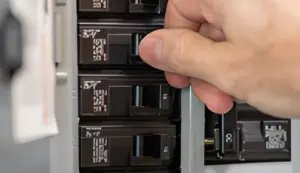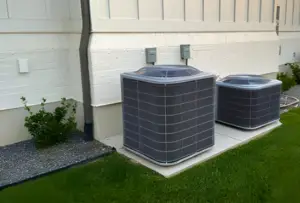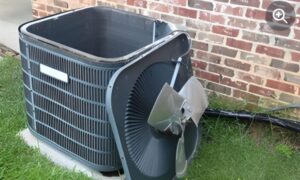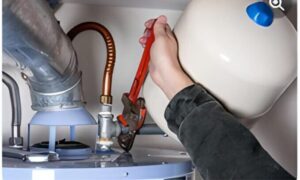In a groundbreaking move, heat pump giants have taken the lead in revolutionizing cold climate heating by introducing innovative and efficient technologies. With the recent development of prototypes that can deliver 100% heating capacity without auxiliary heat, even in frigid temperatures as low as 5 degrees Fahrenheit, the possibilities for energy-efficient heating solutions are expanding rapidly.
These advancements have the potential to significantly reduce energy consumption, cut utility bills, and lower carbon emissions. But how exactly do these heat pumps work, and what makes them so effective in cold climates?
Let's explore the fascinating world of heat pump technology and how it is reshaping the way we heat our homes and buildings.
The Rise of Heat Pump Giants
The rise of heat pump giants has revolutionized the residential cold climate heating industry. With the production of prototypes by four additional manufacturers, there's a growing momentum to accelerate the deployment of heat pump technologies. The goal is to address technical challenges and market barriers, ultimately providing homeowners with efficient and cost-effective heating solutions.
These prototypes have the capability to deliver 100% heating capacity without the need for auxiliary heat, even at temperatures as low as 5 degrees Fahrenheit. Heat pumps offer numerous benefits, including clean heating and cooling, potential savings of $500 or more on utility bills, and a reduction in harmful carbon emissions.
Industry partners such as Bosch, Daikin, Midea, and Johnson Controls are actively collaborating to install and monitor over 23 prototypes in various cold-climate locations. Together, they're working towards encouraging adoption through programs, incentives, and education campaigns.
The role of heat pumps in energy consumption can't be understated, as heating and cooling buildings account for over 35% of US energy consumption. Heat pumps provide energy-efficient solutions, especially when combined with proper insulation, and can also contribute to more efficient water heating.
This initiative is part of the broader E3 Initiative, which focuses on better energy, emissions, and equity, aligning with President Biden's goals for a carbon pollution-free electricity and net-zero carbon economy.
Overcoming Cold Climate Challenges
To overcome the challenges of cold climates, manufacturers and industry partners are actively working together to develop innovative heat pump technologies. These technologies aim to address the technical challenges and market barriers associated with cold climate heating.
Prototypes have already been produced by four additional heat pump manufacturers, delivering 100% heating capacity without the need for auxiliary heat. These prototypes have also demonstrated higher efficiencies at temperatures as low as 5 degrees Fahrenheit.
In order to encourage widespread adoption, industry partners such as Bosch, Daikin, Midea, and Johnson Controls are collaborating with state, utility, and other partners to install and monitor over 23 prototypes in various cold-climate locations. Additionally, programs, incentives, and education campaigns are being developed to raise consumer awareness about the benefits of heat pumps in cold climates.
Benefits of Revolutionary Heat Pump Technology
Revolutionary heat pump technology offers numerous benefits, including clean heating and cooling, potential utility bill savings of $500 or more, and a significant reduction in harmful carbon emissions.
Heat pumps provide clean heating and cooling solutions, ensuring a more environmentally friendly and sustainable approach.
With the potential savings of $500 or more on utility bills, homeowners can enjoy cost-effective heating and cooling solutions.
Additionally, these heat pumps contribute to a significant reduction in harmful carbon emissions, helping to combat climate change. By utilizing electricity as their power source, heat pumps reduce on-site greenhouse gas emissions by up to 50%.
This technology not only provides efficient heating and cooling but also plays a crucial role in achieving energy efficiency and reducing our carbon footprint.
Leading Industry Partners and Collaborators
Leading industry partners and collaborators include Bosch, Daikin, Midea, and Johnson Controls, who've joined the Residential CCHP Technology Challenge to revolutionize cold climate heating with their innovative heat pump prototypes.
These renowned companies have recognized the importance of addressing the technical challenges and market barriers associated with cold climate heating. By actively participating in the challenge, they aim to deliver heat pump prototypes that can provide 100% heating capacity without the need for auxiliary heat, even at temperatures as low as 5 degrees Fahrenheit.
With their expertise and resources, these industry giants are contributing to the development and deployment of highly efficient heat pump technologies that offer clean heating and cooling solutions.
Through collaboration with state, utility, and other partners, they're also working towards encouraging widespread adoption of these innovative solutions through programs, incentives, and education campaigns.
Heat Pumps: Key Players in Energy Efficiency
Heat pumps play a crucial role in improving energy efficiency by providing highly efficient heating and cooling solutions. These innovative devices are key players in reducing energy consumption and promoting sustainability.
Heat pumps are especially effective when combined with proper insulation, as they can significantly reduce the heating and cooling needs of buildings. Compared to traditional heating methods such as gas boilers, heat pumps can reduce on-site greenhouse gas emissions by up to 50%.
Additionally, heat pumps offer efficient water heating capabilities, further contributing to energy savings. By utilizing electricity as their power source, heat pumps also help in reducing on-site greenhouse gas emissions, making them an environmentally friendly choice.
With their ability to provide clean heating and cooling, heat pumps are a vital component in achieving energy efficiency and reducing carbon emissions.
The E3 Initiative: Driving Change and Equity
As the focus shifts towards driving change and equity in energy efficiency, the E3 Initiative takes center stage in promoting a more sustainable future.
The E3 Initiative, which stands for the Initiative for Better Energy, Emissions, and Equity, is part of the Residential Cold Climate Heat Pump Challenge. Run by the U.S. Department of Energy's Building Technologies Office in the Office of Energy Efficiency and Renewable Energy, the E3 Initiative aims to address technical challenges and market barriers in the adoption of heat pump technologies.
In partnership with the U.S. Environmental Protection Agency and Natural Resources Canada, the E3 Initiative aligns with President Biden's goals for carbon pollution-free electricity and a net-zero carbon economy.
Transforming Residential Heating and Cooling
The transformation of residential heating and cooling is driving a more sustainable future and promoting energy efficiency and equity. Heat pump giants, including Bosch, Daikin, Midea, and Johnson Controls, are revolutionizing the industry with their prototypes that deliver 100% heating capacity without auxiliary heat and higher efficiencies even at 5 degrees Fahrenheit.
These heat pumps offer numerous benefits, such as clean heating and cooling, potential savings of $500 or more on utility bills, and a reduction in harmful carbon emissions. With industry partners collaborating on the installation and monitoring of over 23 prototypes in various cold-climate locations, the goal is to address technical challenges and market barriers, while also developing programs, incentives, and education campaigns to encourage adoption.
The role of heat pumps in energy consumption is significant, as heating and cooling buildings contribute to over 35% of US energy consumption. By providing energy-efficient solutions, especially when combined with proper insulation, heat pumps can significantly reduce greenhouse gas emissions compared to gas boilers.
This transformation aligns with the Initiative for Better Energy, Emissions, and Equity (E3 Initiative), which aims to promote a net-zero carbon economy and carbon pollution-free electricity.
Heat Pumps: A Game-Changer for Carbon Reduction
With their ability to significantly reduce carbon emissions, heat pumps have become a game-changer in the quest for a more sustainable future. Heat pumps provide clean heating and cooling solutions, offering potential savings of $500 or more on utility bills. Compared to gas boilers, heat pumps can reduce on-site greenhouse gas emissions by up to 50%. They're electricity-powered, further reducing on-site greenhouse gas emissions.
In addition to their heating and cooling capabilities, heat pumps can also provide efficient water heating. This is especially effective when combined with proper insulation. With the heating and cooling of buildings contributing to over 35% of US energy consumption, the adoption of heat pumps can play a crucial role in reducing energy consumption and achieving carbon reduction targets.
Towards a Sustainable Future: The Heat Pump Revolution
Leading the charge towards a sustainable future, the revolution of heat pump technology is set to transform the way we heat and cool our buildings. Heat pumps provide a clean and efficient solution for heating and cooling, offering potential savings of $500 or more on utility bills while reducing harmful carbon emissions.
With electricity powering the heat pump, on-site greenhouse gas emissions can be reduced by up to 50%. The industry is working together to accelerate the adoption of heat pump technologies, with major players like Bosch, Daikin, Midea, and Johnson Controls joining as partners.
Through collaboration with state, utility, and other partners, programs, incentives, and education campaigns are being developed to increase consumer awareness. By addressing technical challenges and market barriers, heat pumps have the potential to play a significant role in achieving a sustainable and energy-efficient future.
Frequently Asked Questions
How Do Heat Pumps Work to Provide Both Heating and Cooling?
Heat pumps work by transferring heat from one place to another.
For cooling, they extract heat from the indoor air and release it outside. This is done through the process of refrigeration, where a refrigerant absorbs the heat and evaporates. The warm refrigerant is then compressed, which increases its temperature.
For heating, the process is reversed, with the heat pump extracting heat from the outdoor air or ground and transferring it indoors.
This allows heat pumps to provide both heating and cooling capabilities in an energy-efficient manner.
What Are the Potential Cost Savings for Homeowners Who Switch to Heat Pump Technology?
Potential cost savings for homeowners who switch to heat pump technology can be significant. On average, homeowners can save $500 or more on their utility bills by using heat pumps for both heating and cooling.
This is because heat pumps are highly energy-efficient and can reduce electricity consumption compared to traditional heating and cooling systems.
Additionally, heat pumps help to lower carbon emissions, contributing to a greener and more sustainable home.
How Do Heat Pumps Contribute to Reducing Carbon Emissions?
Heat pumps contribute to reducing carbon emissions by providing clean heating and cooling solutions for residential buildings. Compared to gas boilers, heat pumps can reduce on-site greenhouse gas emissions by up to 50%.
They're electricity-powered, which helps to reduce on-site greenhouse gas emissions even further. By using heat pumps, homeowners can significantly reduce their carbon footprint and contribute to a more sustainable and environmentally friendly future.
What Types of Incentives and Programs Are Being Developed to Encourage Consumer Adoption of Heat Pumps?
Incentives and programs are being developed to encourage consumer adoption of heat pumps. These initiatives aim to increase awareness and understanding of heat pump technology among consumers.
They include the development of educational campaigns, incentives, and rebate programs to make heat pumps more affordable and accessible.
How Does the E3 Initiative Align With President Biden's Goals for Addressing Climate Change?
The E3 Initiative, which includes the Residential CCHP Technology Challenge, aligns with President Biden's goals for addressing climate change.
Run by the DOE's Building Technologies Office, it focuses on better energy, emissions, and equity.
By promoting the deployment of heat pump technologies, the initiative aims to reduce carbon pollution and achieve a net-zero carbon economy.
This supports President Biden's vision of transitioning to clean energy sources and combating climate change.
Conclusion
In conclusion, the rise of heat pump giants and their innovative technologies is revolutionizing cold climate heating. These prototypes have shown the ability to deliver 100% heating capacity without auxiliary heat, achieving higher efficiencies even at low temperatures.
With numerous benefits such as clean heating, potential savings on utility bills, and a reduction in carbon emissions, heat pumps are becoming key players in energy efficiency.
Collaborations with industry partners and the E3 Initiative are driving change and promoting widespread adoption, leading us towards a sustainable future.








